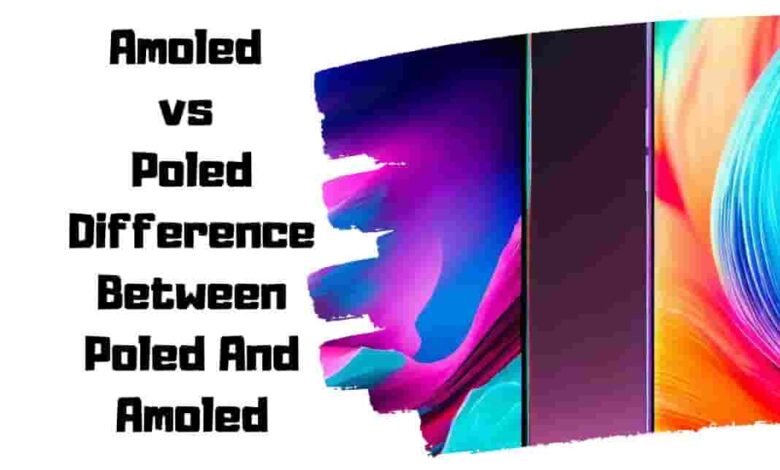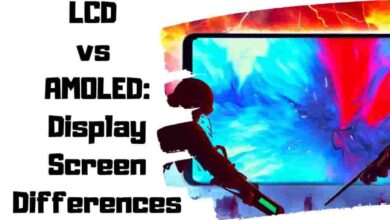Amoled vs Poled: Difference Between Poled And Amoled

As you dive into the world of advanced display technologies, you’ll likely come across two popular types: AMOLED and POLED. Both of these cutting-edge displays offer stunning visuals and excellent performance, but do you know what sets them apart from each other? In this comprehensive guide, we will explore the differences between Amoled vs Poled to help you understand which one is better suited for your needs.
You’re probably curious about how these displays work and what makes one superior. Well, buckle up! We’ll delve deep into the intricacies of AMOLED and POLED screens, comparing their features and capabilities to understand their strengths and weaknesses clearly.
By the end of this article, you will be able to distinguish between these two sophisticated display technologies and be equipped with valuable insights that will satisfy your subconscious desire for mastery in this domain.
So sit back, relax, and embark on an enlightening journey through the OLED world!
Contents
What Are OLED Displays?
You might not realize it, but OLED displays transform your viewing experience with stunning visuals and vibrant colors, taking your screen time to a new level. AMOLED and POLED are two popular variations of OLED display technologies that have been making electronic waves.

These organic light-emitting diodes (or OLEDs) consist of pixels made from organic materials that light up individually when an electric current passes through them, resulting in richer colors, deeper blacks, and faster refresh rates compared to traditional LCD screens, which rely on backlighting.
Both AMOLED (Active Matrix Organic Light Emitting Diodes) and POLED (Plastic-OLED) displays boast impressive benefits thanks to the inherent advantages of using organic compounds.
AMOLED screens offer excellent color reproduction and energy efficiency since each pixel can be controlled independently. On the other hand, POLED technology uses a flexible plastic substrate instead of glass, allowing for thinner, lighter displays that can even be bent or folded without any loss in performance or quality.
As you continue engaging with these cutting-edge display technologies on your TVs, mobile phones, laptops, or other electronic devices, you’ll undoubtedly appreciate their brilliance in your everyday digital experiences.
Overview OLED Technologies Available Today
So, you’re curious about the different OLED technologies out there today, huh? Let’s dive right in and explore what each one has to offer! These display panels are all based on organic light-emitting diodes (OLED).
Still, they come with unique features that cater to different needs. Some of the most popular types of OLED displays you’ll encounter include:
AMOLED Display:
AMOLED stands as the most prevalent OLED technology in smartphones and OLED TVs. It employs thin-film transistors (TFTs) as semiconductors, significantly improving efficiency compared to other display technologies like LED and LCD. The result is vibrant visuals, deep blacks, and power savings.
POLED Displays:
POLED takes OLED technology to the next level using plastic substrates instead of glass. This innovation enhances flexibility and durability, making it ideal for curved and foldable displays. POLED displays offer a seamless viewing experience with exceptional image quality.
PMOLED (Passive-Matrix OLED):
PMOLED is an earlier form of OLED technology with slower refresh rates and lower efficiency than AMOLED. It is commonly used in smaller displays, such as those found in digital cameras.
Super AMOLED:
Super AMOLED combines the advantages of AMOLED with an integrated touch function. It is predominantly found in smartphones and tablets, offering vivid colors, sharp details, and precise touch responsiveness.
OLED (Organic Light-Emitting Diode):
OLED is a flat light-emitting technology that harnesses organic compounds to generate light. Remarkably, each pixel acts as its source of color and light, eliminating the need for a separate backlight. This results in thinner and more flexible displays and enhances overall image quality.
As an enthusiast seeking mastery in OLED technology, it’s essential to understand each display type’s advantages. For instance, AMOLED stands out for its power savings and deep blacks due to its active-matrix design using thin-film transistors (TFTs).
Meanwhile, POLED takes flexibility to new heights by replacing the glass with more durable plastic substrates – making it ideal for curved or foldable devices.
Lastly, Super AMOLED combines the best of both worlds by fusing AMOLED with touch capabilities for precise interactions on smartphones and tablets.
So immerse yourself in these cutting-edge technologies that continue to push visual experiences further than ever!
Definition of AMOLED
Well, isn’t it fascinating how AMOLED displays have become the darlings of the tech world with their energy efficiency and vibrant colors? By combining organic light-emitting diodes (OLEDs) with active matrix technology, these screens can deliver a visually amazing experience while keeping power consumption in check.

This is particularly important for modern devices like Android phone and smartwatches that need to balance high-quality visuals with battery life.
The result is an impressive display screen that boasts deep blacks, bright hues, and quick response times – perfect for all your multimedia needs. To better understand the advantages of AMOLED screens, let’s take a look at this handy table:
| Feature | Description | Benefit |
|---|---|---|
| Organic Light-Emitting Diodes | It uses carbon-based materials to emit light when electrically activated | It provides brighter colors and deeper blacks |
| Active Matrix Technology | Integrates pixels into a thin-film transistor array for precise control | Reduces power consumption and improves refresh rates |
| Thin-Film Transistor Array | Switches currently to each pixel individually through dedicated circuits | Allows for faster response times and better overall performance |
| Vibrant Colors & Deep Blacks | High contrast ratios make images appear more lifelike and vivid on-screen | Enhances visual quality across different devices |
| Energy Efficiency | Consumes less power than traditional LCD or LED displays | Prolongs device battery life while maintaining top-notch visuals |
As you can see from the table above, AMOLED screens offer numerous benefits over other display technologies. Its combination of organic light-emitting diodes, active matrix technology, TFT arrays, vibrant colors, and lower power consumption make these screens ideal for various applications.
So indulge your subconscious desire for mastery by further exploring the world of AMOLED displays!
Definition of POLED
Now that you’ve delved into the world of AMOLED displays, it’s time to explore an even more exciting technology: POLED screens, which take flexibility and durability to a whole new level.

Standing for Polymer Organic Light-Emitting Diodes, POLED technology is a game-changer in display quality and innovation. Using plastic substrates like polyethylene terephthalate instead of glass substrates found in AMOLEDs, POLED screens can be bent and folded without compromising performance or integrity.
Some key advantages of POLED displays include the following:
Flexibility:
Their plastic substrate construction makes them bendable and quickly adapt to curved or folding designs.
Durability:
The shock-resistant nature of plastic substrates makes this smartphone displays less prone to damage from accidental drops or impacts.
Slimmer profile:
With thinner dimensions than glass-based OLEDs, POLED screens add a sleek touch to gadgets while maintaining impressive display quality.
Design versatility:
Folding electronic components behind the screen allows for reduced bezel sizes and more immersive visuals on smartphones and other devices.
With all these benefits combined, it’s no surprise that companies like LG Display have trademarked their versions of this cutting-edge technology – pOLED – which is now used in various products ranging from phones to wearables.
So next time you’re shopping for a new gadget with a top-of-the-line screen, keep an eye out for those boasting POLED or pOLED displays; they could very well be pushing boundaries regarding what you thought was possible regarding visual experience and device design.
Differences Between AMOLED and POLED Displays
While both OLED technologies offer impressive visual experiences, it’s crucial to understand the distinctions between AMOLED and POLED displays in terms of flexibility, durability, and design innovation.

These differences are primarily due to using different substrate materials: glass in AMOLED displays and plastic in POLED displays.
By choosing one over the other, you’ll be able to find a display that meets your specific needs for flexibility, durability, performance, or aesthetics. To help visualize these differences, let’s take a look at this table:
| Feature | AMOLED | POLED |
|---|---|---|
| Substrate Material | Glass | Plastic |
| Flexibility | Limited | High |
| Durability | Moderate | Superior |
| Bezel Size & Design | Larger bezels | Smaller bezels |
| Thickness | Thicker | Thinner |
As you can see from the table above, one of the most significant differences between POLED and AMOLED is their flexibility; POLED displays have an edge due to their plastic substrates allowing for curved and bending designs.
Regarding durability, POLED screens outlast their AMOLED counterparts because they’re better protected against accidental drops and knocks. Additionally, designers can reduce bezel size with POLED technology by folding electronics under the display’s edge – enhancing visual immersion.
Lastly, concerning thickness and weight implications on device design, POLED stands out as a thinner option than its glass-based rival.
However, it’s essential not to overlook that AMOLEGRO screens often deliver better optical performance than their flexible counterparts due to superior transparency, which enhances color vibrancy and pixel density.
Furthermore, factors such as display brightness or response time might also be essential in determining which OLED technology suits you best.
Ultimately though – armed with a deeper understanding of the distinctions between AMOLED and POLED displays – you’re now better positioned to make an informed decision that will cater to your desire for mastery and immerse you into a visually stunning world.
Which One Is Better?
So, which display technology should you choose for the ultimate visual experience? The answer largely depends on your priorities and the specific device you want to use.
If performance and image quality are at the top of your list, AMOLED might be your better option. With faster refresh rates, wider viewing angles, and higher contrast ratios, AMOLED displays deliver stunning visuals that make everything from movies to video games look more lifelike and immersive.
Additionally, AMOLED screens consume less power when displaying darker images or colors, which can lead to improved battery life in some cases.
On the other hand, if durability and design flexibility are more important to you than raw performance, POLED display technology could be a better fit.
Thanks to their plastic substrates, POLED screens offer greater resilience against shocks and impacts while allowing for thinner designs and unique form factors such as curved or foldable displays.
Though they may not offer quite the same level of image quality as their AMOLED counterparts, POLED panels still provide excellent visuals while opening up new possibilities for innovative device designs.
Ultimately, it’s a matter of weighing your preferences and considering how each type of display will best suit your needs before deciding.
Conclusion
So, you’ve finally reached the epic showdown between AMOLED and POLED displays. Aren’t you just thrilled? It would be best if you were because deciding which is “better” is like choosing between a gourmet burger or a fancy pizza – it’s all about personal preference.
Go ahead, embrace your inner tech snob! Remember, whether you’re team AMOLED or team POLED, at the end of the day, both technologies deliver jaw-dropping visuals that will keep your eyes glued to your screens.

